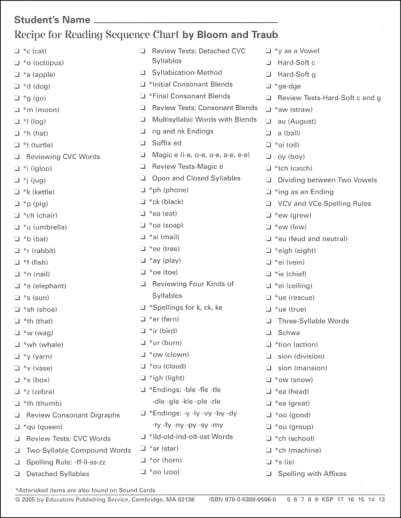Sequence Charts is a pad of 50 copies of the sound presentation sequence designed to be used as a checklist (one per child). This same Sequence Chart is included inside the front cover of the Teacher's Manual.
Recipe for Reading Sequence Charts (pad of 50)
Description
This pad of 50 Sequence Charts can be used to record the individual progress of each child through the Recipe for Reading program. The charts are designed to accommodate variable learning rates within the carefully planned stages of the program. Charts are included in the Recipe for Reading Basic Kit and the Recipe for Reading Storybook Kit, and are also available separately.
Recipe for Reading is a three-year phonics/reading program based on the Orton-Gillingham methodology that won’t break the bank. Sound like a win-win? Targeting struggling readers but useable for all students, the teaching materials were developed for tutors. If you have a child who is struggling with learning to read or who you suspect might have dyslexia, or if you just want a solid phonics/reading program, this is also one to consider.
As with any recipe, the Recipe for Reading program allows you to know what ingredients are needed, understand how they are to be combined, and be able to adapt the recipe to individual needs and differentiated circumstances. The research-based teaching methodology provides systematic instruction that combines phonemic awareness and phonics with fluency, vocabulary, and comprehension. Lessons follow a pattern (as you may expect). Sounds with examples are presented, reviewed, and reinforced. Decodable words are taught with each lesson followed by decodable sentences that can be used for both dictation and reading. Rhyming nonsense words provide a bit of fun and practice. Workbook reinforcement gives the student lots of practice. The coordinating Alphabet Series Readers provide enjoyable and ample reading practice. Everything fits together into a cohesive whole – a whole designed to be one to three years of phonics/reading instruction.
The Teacher’s Manual is essential and central to the program, as it provides an overview as well as lessons for each of the 67 sounds that make up this program. 97 lessons cover these sounds plus additional lessons on syllabication rules, prefixes, and suffixes, as well as review. Sample scripted lessons are provided, but individual lessons are not scripted; they are carefully laid out and coordinated with both workbooks and Alphabet Series Readers. This program provides the basics and leaves room for you to add creativity. It includes elements that I consider to be important – systematic phonics, lots of reading practice including words and phrases, an emphasis on learning the meaning of words as well as regular comprehension checks – but encourages flexibility, pacing geared to the child, and incorporation of multi-sensory applications.
| Product Format: | Other |
|---|---|
| Grades: | K-6 |
| Brand: | Educators Publishing Service |
| ISBN: | 9780838805060 |
| Length in Inches: | 11 |
| Width in Inches: | 8.5 |
| Height in Inches: | 0.25 |
| Weight in Pounds: | 0.6 |

